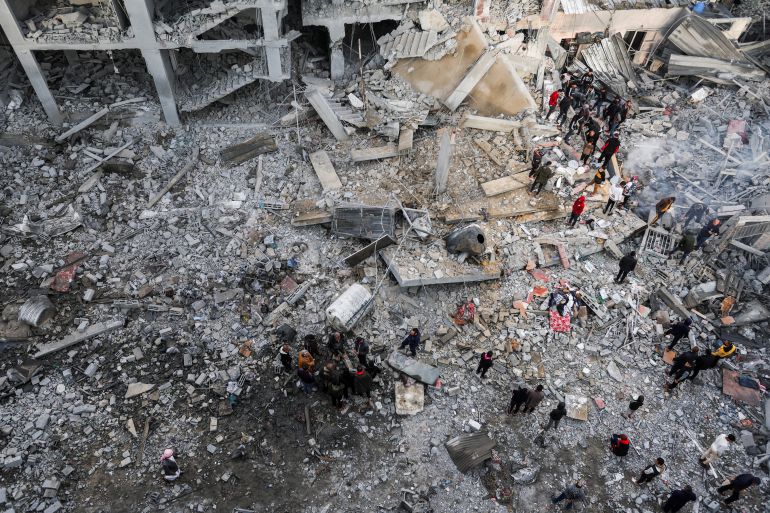Israel is taking scorched earth policy to a new level
Gaza is not the first place where Israel is inflicting or helping inflict mass devastation. But it is the first to see it on this shocking scale.

In October, shortly after the start of the Israeli war on Gaza that has now killed nearly 20,000 Palestinians, Israel pledged to wipe Hamas “off the face of the earth” – a project that would require Israel’s military “to flatten the ground” in Gaza, as an Israeli security source told the Reuters news agency.
And flatten they did; one month into the war, the military had already dropped the equivalent of two nuclear bombs on the diminutive and densely populated Palestinian coastal enclave. Now, as Israel continues to pulverise an already thoroughly pulverised territory, it seems the Israelis may be taking the concept of scorched earth policy to a whole new level.
Keep reading
list of 4 itemsFrom LA to NY, pro-Palestine college campus protests grow strong in US
‘Left to bleed out’: Israeli forces kill two Palestinians in West Bank
Is the crackdown on US university campuses a threat to free speech?
According to the Oxford Reference dictionary, the term “scorched earth policy” was first utilised in English in 1937 in a report describing the Sino-Japanese conflict, in which the Chinese levelled their own cities and burned crops in order to complicate the Japanese invasion. The strategy has since been seen in an array of armed conflicts worldwide, including the 36-year civil war in Guatemala that ended in 1996 after killing and disappearing more than 200,000 people, primarily Indigenous Mayans.
In 2013, former Guatemalan dictator and United States buddy Efraín Ríos Montt – who oversaw a particularly bloody segment of the war in the early 1980s – was found guilty of genocide in a Guatemalan court. And while subsequent judicial machinations and Ríos Montt’s own death by heart attack saved the man from earthly atonement for his crimes, you might say the truth is not so easily wiped “off the face of the earth”.
Indeed, scorched earth was a primary component of the Guatemalan army’s genocidal approach to its adversaries, and hundreds of Indigenous villages were destroyed along with water supplies, crops, and anything else that might sustain life. And what do you know: Guatemalan state savagery was boosted by none other than the state of Israel, which after all already had several decades of experience in eradicating Indigenous life in Palestine – pardon, “making the desert bloom”.
As journalist Gabriel Schivone notes in an article for the North American Congress on Latin America (NACLA), not only did Israeli advisers help ensure the success of the 1982 military coup that brought Ríos Montt to power, but Israel also “assisted every facet of attack on the Guatemalan people” from the late 1970s into the next decade. For successive Guatemalan governments, Schivone writes, Israel had become the “main provider of counterinsurgency training, light and heavy arsenals of weaponry, aircraft, state-of-the-art intelligence technology and infrastructure, and other vital assistance”.
In keeping with the “desert-blooming” variety of blasphemy, Israel was also credited with assisting Guatemala in agricultural endeavours during the civil war era – since there’s clearly nothing better for agriculture than, you know, scorched earth.
Meanwhile, in neighbouring El Salvador, the United States’s supposedly existential fight against communism during the Cold War also enabled right-wing regimes to slaughter a whole lot of peasants. And like in Guatemala, Israel was standing by to offer a helping hand – including in the implementation of scorched earth policies.
An AJ+ video draws attention to the fact that Israel helped train ANSESAL, the Salvadoran intelligence agency that “would lay the foundation for death squads” during El Salvador’s own 12-year civil war, which killed at least 75,000 people and ended in 1992. According to the video, from 1975 until the start of the civil war in 1979, Israel was the source of a full 83 percent of El Salvador’s military imports. The vast majority of wartime killings were perpetrated by the US-backed right-wing state and associated paramilitary groups.
It goes without saying, of course, that scorched earth campaigns are deadly – and sometimes, that deadliness outlives the conflict itself. Take Vietnam, where the US military’s quite literal scorching of the earth with the toxic defoliant Agent Orange continued to cause miscarriages, birth defects, and severe illnesses decades after the official end of the Vietnam War in 1975.
In Iraq, the US’s use of depleted uranium munitions might also qualify as a scorched earth policy of sorts, as saturating a territory in radioactive poison doesn’t do much to ensure its long-term habitability.
Speaking of poisons, the Washington Post recently confirmed that the Israeli military fired US-supplied white phosphorus rounds at southern Lebanon in October despite the use of such weapons in civilian areas being “generally prohibited under international humanitarian law”. As per the Post’s writeup, south Lebanese residents affected by the attack “speculated that the phosphorus was meant to displace them from the village and to clear the way for future Israeli military activity in the area”.
It certainly wouldn’t be the first time – in Lebanon or in the Gaza Strip, which has seen its fair share of illegal white phosphorus bombardments by Israel.
As the Israeli military now carries on scorching and re-scorching the earth in Gaza and the humans therein along with it, there is a singularity that distinguishes Israel’s efforts from scorched earth experiments of the past. In El Salvador, for example, the army’s goal was never to eliminate the very concept of El Salvador, whereas Israel appears intent on annihilating Gaza altogether.
But unfortunately for Israel, resistance is one thing that can grow in scorched earth.
The views expressed in this article are the author’s own and do not necessarily reflect Al Jazeera’s editorial stance.
